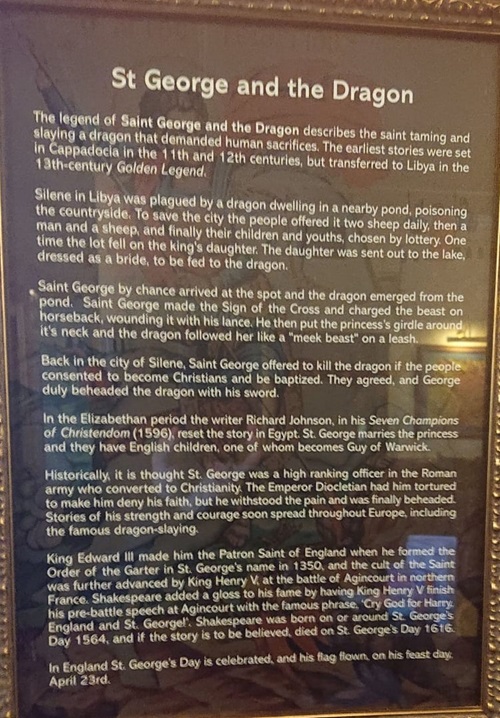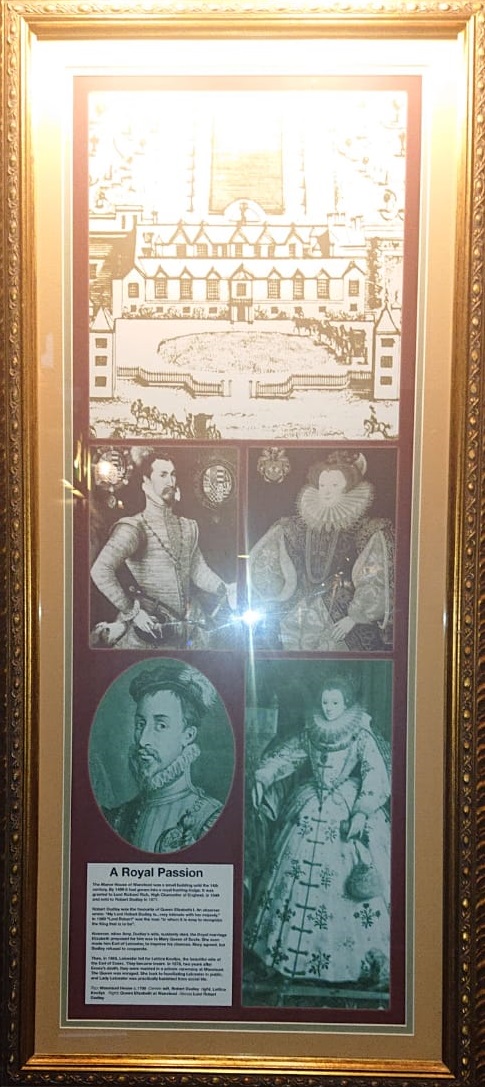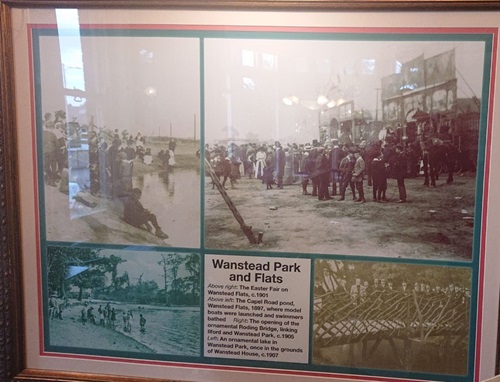155–159 High Street, Wanstead, London, E11 2RL
This pub maintains the name of this fine Edwardian building, completed in 1903. It replaced an earlier George and Dragon Inn which had stood on an adjacent site.
Photographs of The George, Wanstead.

Top: The old George, originally called The George and Dragon, dated from 1716
Above: The new George, 1906, by which time the drinking fountain was in place
Below: The area around The George showing the main houses, 1900
Text about St George and the Dragon.

The text reads: The legend of Saint George and the Dragon describes the saint taming and slaying a dragon that demanded human sacrifices. The earliest stories were set in Cappadocia in the 11th and 12th centuries, but transferred to Libya in the 13th century Golden Legend.
Silene in Libya was plagued by a dragon dwelling in a nearby pond, poisoning the countryside. To save the city the people offered it two sheep daily, then a man and a sheep, and finally their children and youths, chosen by lottery. One time the lot fell on the King’s daughter. The daughter was sent out to the lake, dressed as a bride, to be fed to the dragon.
Saint George by chance arrived at the spot and the dragon emerged from the pond. St George made the Sign of the Cross and charged the beast on horseback, wounding it with his lance. He then put the princess’s girdle around its neck and the dragon followed her like a “meek beast” on a leash.
Back in the city of Silene, Saint George offered to kill the dragon if the people consented to become Christians and be baptized. They agreed and George duly beheaded the dragon with his sword.
In the Elizabethan period the writer Richard Johnson, in his Seven Champions of Christendom (1596), reset the story in Egypt. St George marries the princess and they have English children, one of whom becomes Guy or Warwick.
Historically, it is thought St George was a high ranking officer in the Roman army who converted to Christianity. The Emperor Diocletian had him tortured to make him deny his faith, but he withstood the pain and was finally beheaded. Stories of his strength and courage soon spread throughout Europe, including the famous dragon-slaying.
King Edward III made him the Patron Saint of England when he formed the Order of the Garter in St George’s name in 1350, and the cult of the Saint was further advanced by King Henry V, at the battle of Agincourt in northern France. Shakespeare added a gloss to his fame by having King Henry V finish his pre-battle speech at Agincourt with the famous phrase “Cry God for Harry, England and St George!”. Shakespeare was born on or around St George’s Day 1564, and if the story is to be believed, died on St George’s Day 1616.
In England, St George’s Day is celebrated, and his flag flown, on his feast day, April 23.
Prints and text about Sir William Penn and Son.

The text reads: Admiral Sir William Penn, father of the founder of Pennsylvania, moved to Wanstead with his family soon after his famous son was born. His home is thought to have been the manor house, close to the site of the George. It has been identified with The Elms, although that house, as seen in photographs, was built after Penn’s time.
The future founder spent much of his childhood in Wanstead, he went to school in Chigwell, and was then sent to Oxford University, aged 15, where he developed the devout and pioneering outlook that turned his named into a State.
Sir William was one of the greatest sea captains of his age. He became rear admiral and vice admiral of Ireland, and in 1652, vice admiral of England. He died in Wanstead on 16 September, 1670.
Top left: The Elms (right) close to the newly built George, in 1906
Top right: Admiral Sir William Penn
Left: William Penn, 1692
Above: The old George to the left of The Elms, 1899.
Illustrations and text about royals in Wanstead.

The text reads: The Manor House of Wanstead was a small building until the 14th century. By 1499 it had grown into a royal hunting lodge. It was granted to Lord Richard Rich, high chancellor of England, in 1549 and sold to Robert Dudley in 1577.
Robert Dudley was the favourite of Queen Elizabeth I. An observer wrote: “My Lord Robert Dudley is… very intimate with her majesty”. In 1560 “Lord Robert” was the man “in whom it is easy to recognise the King that is to be”.
However, when Amy, Dudley’s wife, suddenly died, the Royal marriage Elizabeth proposed for him was to Mary Queen of Scots. She event made him Earl of Leicester, to improve his chances. Mary agreed, but Dudley refused to cooperate.
Then, in 1565, Leicester fell for Lettice Knollys, the beautiful wife of the Earl of Essex. They became lovers. In 1578, two years’ after Essex’s death, they were married in a private ceremony at Wanstead. The Queen was enraged. She took to humiliating Leicester in public, and Lady Leicester was practically banished from social life.
Top: Wanstead House, 1700
Centre: left, Robert Dudley, right, Lettice Knollys
Right: Queen Elizabeth at Wanstead
Above: Lord Robert Dudley.
Photographs of Wanstead Park and Flats.

If you have information on the history of this pub, then we’d like you to share it with us. Please e-mail all information to: pubhistories@jdwetherspoon.co.uk